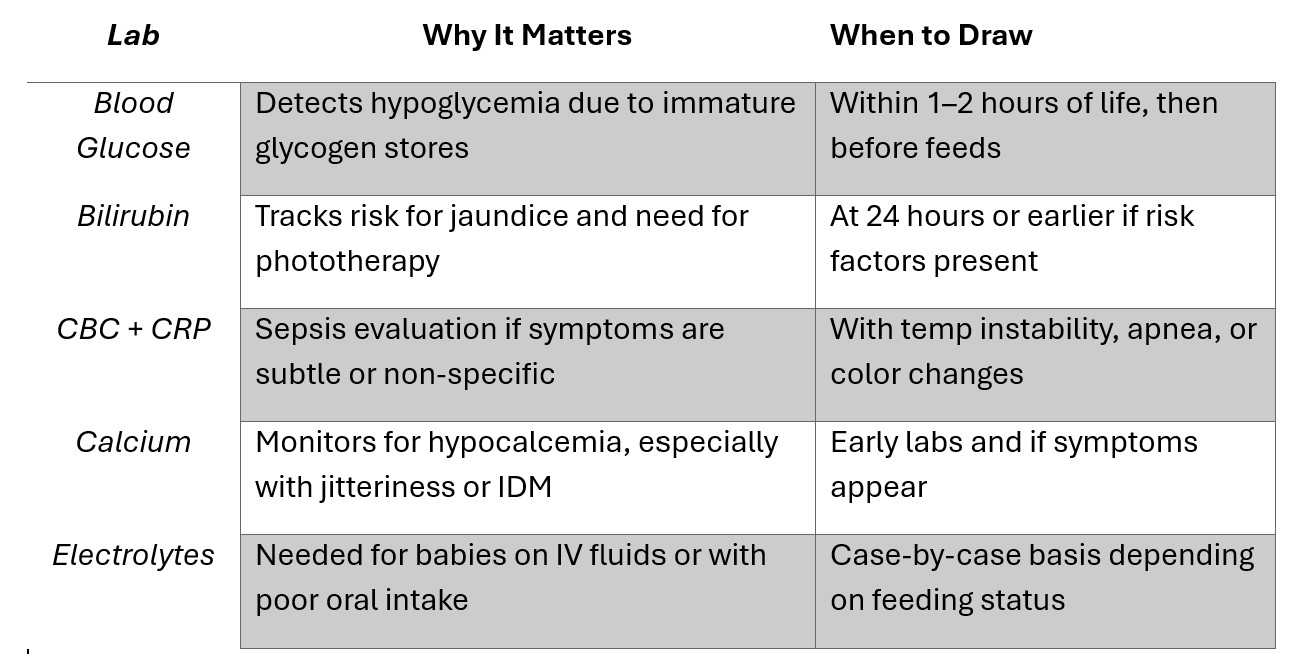
Late Preterm Infants pt 1
Not Quite Term: Caring for the Late Preterm Infant
Teach Me Tuesday Blog – Part 1
When a baby is born between 34⁰⁄₇ and 36⁶⁄₇ weeks, it’s easy to assume they’ll transition like a full-term infant. After all, they look similar — often bigger, breathing on their own, maybe even rooming in. But late preterm infants bring their own set of clinical challenges, and it’s our job in the NICU to anticipate, assess, and act before those “mild” symptoms turn into major complications.
👶 Who Are Late Preterm Infants?
Late preterm infants are defined as those born between 34⁰⁄₇ and 36⁶⁄₇ weeks gestation. While they represent about 75% of all preterm births, they’re often overlooked in terms of risk. These infants appear stable on the surface — but physiologically, many systems remain underdeveloped, including respiratory drive, thermal regulation, feeding coordination, and metabolic stability.
Nurse takeaway: Late preterm does not mean low risk. These babies are in the “gray zone” between stability and subtle instability — and you need to know how to spot it.
🌡️ Common Clinical Issues in Late Preterm Infants
1. Thermoregulation
Late preterms have reduced brown fat, immature hypothalamic control, and thinner skin, which impairs heat conservation.
They are more likely to become cold-stressed, leading to a cascade: hypoglycemia, respiratory distress, and poor feeding.
Watch for:
Axillary temp <97.3°F
Cool extremities despite appropriate bundling
Temperature instability despite a neutral thermal environment
Case insight: A 35^5⁄7 week infant is placed in an open crib after appearing stable. Within 3 hours, their temp drops to 96.8°F, and their blood glucose drops to 44 mg/dL. They're moved to a warmer and fed via NG until stable.
2. Hyperbilirubinemia
Due to immature liver enzyme systems and delayed feeding, late preterms are at high risk for early and severe jaundice.
Why it's concerning:
Bili levels rise faster and higher
Less albumin binding increases risk for kernicterus
Feeding immaturity delays stooling → delayed bili excretion
Nurse takeaway: Late preterm infants are nearly 3 times more likely to require phototherapy than term infants. Begin screening sooner and trend closely.
3. Respiratory Distress
Although their lungs appear well-developed, these infants are still at risk for TTN, RDS, or even apnea of prematurity.
Early signs include:
Grunting, flaring, retracting
Desaturations during feeds
Rapid progression from nasal cannula to CPAP or intubation
Surfactant production continues into term, so babies delivered without labor (especially C-section) may lack adequate lung fluid clearance or surfactant activation.
Nurse insight: Don't underestimate a 36-weeker who’s “just grunting.” Consider a chest X-ray, blood gas, or escalation sooner rather than later.
4. Feeding Immaturity
Late preterm babies fatigue easily at breast or bottle. Their suck–swallow–breathe coordination is immature, and they may not show strong hunger cues.
Clinical challenges:
Inconsistent intake
Risk of aspiration
Slower weight gain
Increased risk for hypoglycemia
Support includes:
Cue-based feeding
Pacing and rest periods
NG feeds to supplement if needed
Nurse takeaway: Don’t push for full PO feeds if baby is fatiguing — quality is better than quantity in the early days.
5. Sepsis Risk
Even late preterms have immature immune systems. Neutrophil function and skin barrier defenses are not yet fully developed.
Look for subtle signs:
Temperature instability (hypothermia can be an early sign!)
Poor perfusion or color changes
Lethargy or feeding intolerance
Increased apnea or bradycardia events
Nurse tip: Always ask: “Could this be sepsis?” — especially in the presence of vague symptoms.
🧪 Labs to Know for Late Preterm Infants

💬 Supporting Parents Through the Gray Zone
For families, having a baby who "looks fine" but needs NICU-level care can be confusing. Late preterm infants may stay 48 hours… or they may stay weeks. The unpredictability is hard.
Key points for parent education:
Why labs and feeds are being closely monitored
Signs of jaundice, hypoglycemia, or poor feeding
What milestones must be met before discharge
That needing support now doesn’t mean something is wrong forever
Nurse voice matters here. Our education and encouragement build trust and reduce fear.
✅ Final Thoughts
Late preterm infants are often underestimated — but in NICU nursing, we know better. These babies require nuanced assessment, flexible feeding plans, early lab monitoring, and thoughtful discharge planning. They’re not term and not fragile preemies — they’re uniquely in-between, and that means our approach must be equally specific.
Next week in Part 2, we’ll dive into:
Vascular access for late preterms (PIVs vs. UVCs)
Feeding progression and readiness
What safe discharge really looks like in this population
Be sure to follow along, and share this with a fellow NICU nurse who’s learning the art of caring for the in-between babies.
